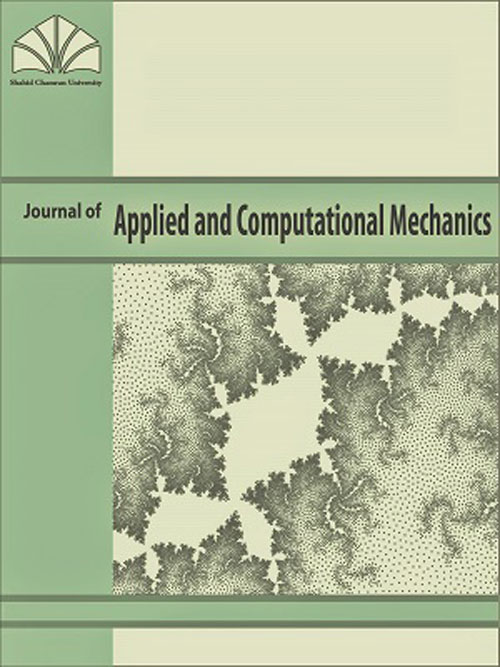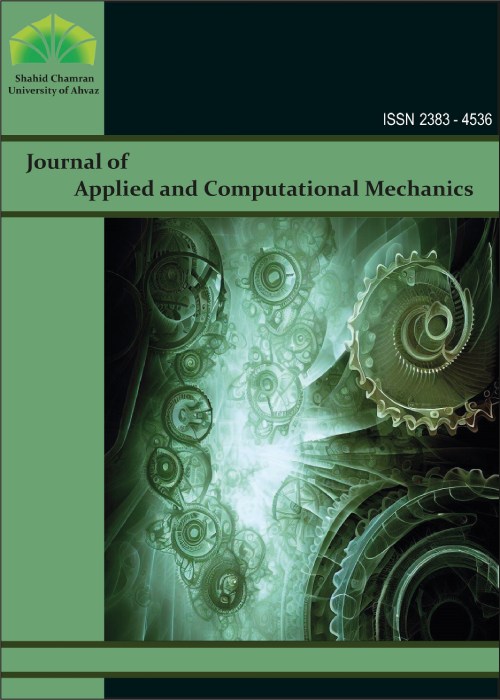فهرست مطالب

Journal of Applied and Computational Mechanics
Volume:3 Issue: 3, Summer 2017
- تاریخ انتشار: 1396/05/30
- تعداد عناوین: 8
-
-
Pages 158-170In this paper, some definitions and traditional formulas for calculating the mobility of mechanisms are represented, e.g. Grubler formula, Somov - Malyshev formula, and Buchsbaum - Freudenstei. It is discussed that there are certain cases in which they are too ambiguous and incorrect to use. However, a matrix method is suggested based on the rank of the Jacobian of the mechanism and its application is investigated. It is shown that the matrix method will definitely lead to a correct answer; however, it is lengthy and consumes more computational effort. It is shown that in the cases the traditional formulas give a wrong answer and the matrix method gives the correct mobility. To compare the methods, several examples are given including the four bar planar linkage, the augmented four bar linkage, University of Maryland manipulator, Cartesian parallel manipulator (CPM), delta robot, orthoglide robot, and H4 parallel robot.Keywords: Degrees of Freedom, Grubler's exceptions, Jacobian rank
-
Pages 171-177Using Computational Fluid Dynamics (CFD) technique, the dispersion contours and the exposure rate of Flexographic printing workers to VOCs in a printing department is evaluated. Firstly, VOCs distribution is determined in the printing room due to the existing ventilation system. Through next steps, 4 scenarios for lowering VOCs concentration and its exposure rate to workers are analyzed. Concentration distributions of ethylene glycol (MEG) as a representative of VOCs are determined for 4 scenarios. The results show that, regarding the existing ventilation, the concentration of MEG at the breathing height is 1×10-5 mg/m3 and it is higher than the standard permissible level. Finally, the findings of this study lead to lowered VOCs concentrations to 13.87×10-9 mg/m3 via changing the ventilation system for the Flexography Printing Room.Keywords: CDF, VOCs pollution, Numerical modelling, Turbulence, Flexography printing
-
Pages 178-184The purpose of introducing ultrasonic vibrations in the tube hydroforming process is to create more formability by obtaining a lower corner radius, improve thickness distribution of the wall and provide good tribological conditions at the tube and the die interface. Vibrations imposed on the die create alternating gaps which improve the formability in the tube hydroforming process in the presence of ultrasonic vibrations. Therefore, we attempted to understand the processing mechanism of the ultrasonic tube hydroforming in the square die using the finite element method. Abaqus software was used in these simulations and the die was considered as a deformable element.Keywords: tube hydroforming, ultrasonic oscillations, Finite Element Method, square die
-
Pages 185-191In this study, the thermal performance analysis of porous fin with temperature-dependent thermal conductivity and internal heat generation is carried out using Haar wavelet collocation method. The effects of various parameters on the thermal characteristics of the porous fin are investigated. It is found that as the porosity increases, the rate of heat transfer from the fin increases and the thermal performance of the porous fin increases. The numerical solutions by the Haar wavelet collocation method are in good agreement with the standard numerical solutions.Keywords: Haar wavelet method, Porous Fin, Thermal Analysis, Temperature, Dependent Thermal Conductivity, Internal Heat Generation
-
Pages 192-198Thermal hydraulics of nuclear reactor as a basis of reactor safety has a very important role in reactor design and control. The thermal-hydraulic analysis provides input data to the reactor-physics analysis, whereas the latter gives information about the distribution of heat sources, which is needed to perform the thermal-hydraulic analysis. In this study single heated channel model as a very fast model for predicting thermal hydraulics behavior of pressurized water reactor core has been developed. For verifying the results of this model, we used RELAP5 code as US nuclear regulatory approved thermal hydraulics code. The results of developed single heated channel model have been checked with RELAP5 results for WWER-1000. This comparison shows the capability of single heated channel model for predicting thermal hydraulics behavior of reactor core.Keywords: Nuclear Reactor, Thermal hydraulics, RELAP5, single heated channel model
-
Pages 199-207This research deals with free vibration and static bending of a simply supported functionally graded (FG) plate with the porosity effect. Material properties of the plate which are related to its change are position-dependent. Governing equations of the FG plate are obtained by using the Hamiltons principle within first-order shear deformation plate theory. In solving the problem, the Navier solution is also used. In this study, the effect of the porosity and material distribution parameters on the static and vibration responses of the FG plate is presented and discussed.Keywords: Functionally Graded Plate, Porosity, Static Analysis, vibration analysis
-
Pages 208-217In this paper, free and forced vibration of simply-supported Single-walled carbon nanotube is investigated under the moving nanoparticle by considering nonlocal cylindrical shell model. To validate the theoretical results, modal analysis of nanotube is conducted using ANSYS commercial software. Excellent agreement is exhibited between the results of two different methods. Furthermore, the dynamic response of SWCNT under moving nanoparticle is also studied. It is assumed that the nanoparticle travels along the center of nanotube with constant velocity and the van der Waals force between CNT and particle is taken into account. The dynamic response of the SWCNT under the influence of C60 particle obtained using dynamic Greens function and modal expansion. The obtained results show that the nonlocal scale effect decreases the natural frequency and dynamic displacement of the CNT.Keywords: SWCNT, Nonlocal scale effects, Moving nanoparticle, Cylindrical shell, Dynamic, vibration
-
Pages 218-228In the present study, the buckling analysis of the rectangular nanoplate under biaxial non-uniform compression using the modified couple stress continuum theory with various boundary conditions has been considered. The simplified first order shear deformation theory (S-FSDT) has been employed and the governing differential equations have been obtained using the Hamiltons principle. An analytical approach has been applied to obtain exact results from various boundary conditions. Due to the fact that there is not any research about the buckling of nanoplates based on the S-FSDT including the couple stress effect, the obtained results have been compared with the molecular dynamic simulation and FSDT papers which use the Eringen nonlocal elasticity theory. At the end, the results have been presented by making changes in some parameters such as the aspect ratio, the effect of various non-uniform loads and the length scale parameter.Keywords: Nonuniform compression, Modified couple stress theory, S, FSDT


